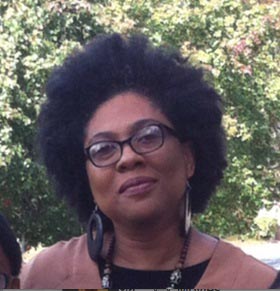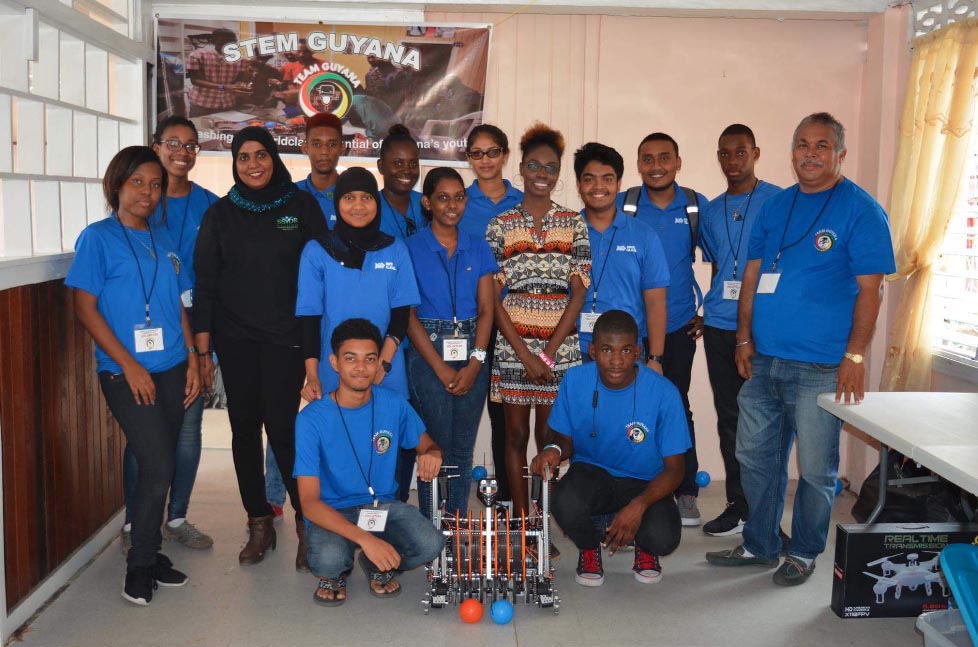Nothing, she says, pleases her more than the modest achievement of Team Guyana at the recent international robotics tournament in Washington and the occasion it afforded for a celebration at home. She was elated to discover that the media at home paid considerable attention to the team’s accomplishment not-withstanding the fact that Guyana had no tradition in robotics to shout about.
But Karen Abrams is not an advocate of protracted celebrations in circumstances where there is much work to be done to create an enhanced national sensitivity to the importance of robotics as a critical developmental tool. Her mind, she says, has already drifted in the direction of building on the accomplishments of Washington. “The world,” she says, “is not standing still, it’s not waiting for us.”
STEMGuyana, the organization which she co-founded after her earlier visit here in 2016 is envisaged as a launch pad for the institutionalization of robotics as a national pursuit. The initiative, she concedes, is ambitious and will need all of the institutional support it can get to develop and grow. It is not just cheering from the sidelines that she needs but material support from both the public and private sectors to help STEMGuyana put down roots here.
“What we are seeking are not charitable donations but investments in Guyana’s future. There is every chance that those contributors to STEMGuyana today will benefit in some way from the work of the organization down the road,” Abrams says. The tone of her assertion is authoritative, as if she is seeking to issue a timely reminder about a serious responsibility.
Asked about a strategy for ensuring that the organization is employed in reaching potential benefactors with “deep pockets,” Abrams says that while STEMGuyana’s appeals will be underpinned by a strong sense of urgency, they will target people’s appreciation of the mission of the organization. “We are appealing to a sense of nationalism, a sense of understanding what’s at stake here,” she adds.

STEM, the acronym for science, technology, engineering and mathematics, describes the methodology for combining those disciplines to help drive countries’ development. Robotics is a manifestation of the application of STEM and, Abrams believes, one of the keys to revolutionizing the agenda of young Guyanese for both leisure and learning.
There has, she says, been some encouraging local support for STEMGuyana and its objectives and here she unhesitatingly singles out First Lady Sandra Granger whom, she says, quickly saw the vision of STEMGuyana. “She was enthusiastic from the beginning and helped to make the programme possible by offering resources that were crucial to my getting the opportunity to enable STEMGuyana put down roots.” Setting that aside, Abrams says, “the First Lady made herself available to open and close our robot-building event and our earlier 2016 Camp. More than that she was instrumental in helping to promote our National Grade Six Assessment mathematics app. about which more will be heard in the months ahead.”
Tactfully, she declines, for the moment to ‘name names’ amongst the private sector entities that have already contributed (others have made promises) to the mission of STEMGuyana. What she says she seeks to do shortly is to aggressively engage the major business support organizations including the Private Sector Commission, the Georgetown Chamber of Commerce and Industry and the Guyana Manufacturers and Services Association among others. “I say again that we are not seeking charitable handouts. We believe that these same organizations can be made to see a connection between the STEMGuyana agenda and their own business interests. I really do not need to go into detail regarding the benefits that can be derived from the development of a robotics regime for the growth of the business sector in Guyana.
The sense of urgency that she brings to her appeal for robust national investment in the discipline is driven, she says, by a realization that since it was first recognized as a field in 20th century, the science of robotics has contributed to considerable productivity and efficiency gains across a wide range of industries, not least, manufacturing. Abrams points out that since the turn of the century robotics and automation technologies have evolved to be a vital part of the technology for development, improving the quality of lives in underserved and underrepresented communities worldwide.
Flushed with their success in Washington the STEMGuyana team is already embracing ambitions which the casual observer might consider to be beyond their capabilities. When last Stabroek Business engaged Abrams on the telephone from her home in Atlanta, Georgia, she disclosed that the youngsters had commenced work on a project the objective of which is to design, build and test a robot that is able to clean trenches in Guyana though she quipped that the project is still to arrive at a point where the organization can contemplate the signing of a contract with the Georgetown Munici-pality. She disclosed that STEMGuyana plans to extend an invitation to students from the Government Technical Institute to participate in the project.
On August 3 a 15-member team of STEMGuyana members completed the first leg of a planned national sensitization outreach, visiting young people in West Coast Berbice. Abrams says the initiative was made possible through “the kindness of various good friends” and she names the Office of the First Lady, the Department of Culture, Youth and Sport, Holly Benn, Creative Arts, Romaine Benn and Youth Advocate Sheezna Seetayah. Abrams says the focus of the West Berbice visit – which will extend to other communities – was to make residents aware of robot technology and ways in which it can impact Guyana’s development. “I suppose that what we are aiming to do is to start a process that will ultimately lead to young people becoming intimate with robot technology.”
She returns to the subject of support for the growth of STEMGuyana “and all that it promises.” Work has already commenced with engaging the local telephone service providers. “We are hopeful that the tech savvy companies in the private sector will be amongst the local companies that will be most interested in providing material support for the project. The reality is that we need to reach out to those who can help and who are aware of what we are seeking to accomplish.”
Abrams hopes, too, that government can be “an active partner” in the process. She explains that STEMGuyana’s intensification on the adaptation of the mathematics app to meet the needs of students preparing for the Grade Six examination ought to see enhanced cooperation between STEMGuyana and the Ministry of Education. “Again one needs to make the point that modest investments in aspects of the development of STEMGuyana can incrementally amount to a great deal. It is for us, government, private sector and other stakeholders to make a collective decision.






